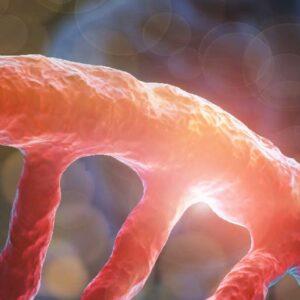Scientific Background
Congenital myopathies describe a separate disease entity among the myopathies that are usually present from birth and progress either slowly or not at all. There are also severe, fatal, and late (in adulthood) manifesting forms. It is a rare, heterogeneous disease group with an estimated prevalence of 1:25,000 and a highly variable spectrum of symptoms. Pathogenic variants in more than 20 genes are known to lead to the expression of one of the muscle diseases from this group.
Muscle weakness and atrophy as well as symmetrical, proximal paresis without sensory disturbances are paramount. Attempts have been made to classify the various (sub)types on the basis of biopsied muscle tissue. Structural abnormalities within the muscle fibers, such as structural defects, abnormal inclusions and/or core anomalies may be present. However, an underlying myopathological pattern of fiber type disproportion is common to all of them, i.e., predominance and selective hypotrophy of type 1 fibers compared to normal (reduction of the diameter of type I muscle fibers by at least 12% compared to type II muscle fibers). A clear classification is often difficult; some forms can be caused by pathogenic variants in different genes or changes in one gene can lead to different types. Nevertheless, a definitive diagnosis is often made or confirmed by molecular genetic examination.
The more frequent, longer known and therefore "classic" congenital myopathies include central core disease (CCD), centronuclear myopathy (CNM) and nemaline myopathy. Other histopathological variants include multiminicore disease (MmD), congenital fiber type disproportion (CFTD) and King-Denborough syndrome.
Autosomal dominant and autosomal recessive pathogenic variants in the RYR1 gene are the most common cause of congenital myopathies. The gene product is a calcium-releasing channel in skeletal muscle associated with coupling of excitation and contraction. Dominant variants in this gene are associated with CCD and/or susceptibility to malignant hyperthermia, while recessive variants are found in patients with MmD, CNM and CFTD.
CCD typically presents at birth with muscle hypotonia and motor developmental delay. The proximal musculature is particularly affected. Muscle biopsy can detect substrate defects "cores" in the oxidative enzyme staining due to a lack of the mitochondria that are usually located in the center of the muscle fibers. Of particular clinical importance is the fact that patients with CCD are often predisposed to malignant hyperthermia, a disease that can be a life-threatening complication of inhalation anesthetic use.
References
Witting et al. 2017, Neurol Genet 3:e140 / Abath Neto et al. 2017, Neuromuscul Disord 27:975 / North et al. 2014, Neuromuscul Disord 24: 97 / Amburgey et al. 2013, Orphanet J of Rare Dis 8:117 / Klein et al. 2012, Hum Mut 33:61 / Amburgey et al. 2011, Ann Neurol 70:662 / Goebel et al. 2009, Pathologe 30:365 / Jungbluth 2007, Orphanet J of Rare Dis 2:25





















